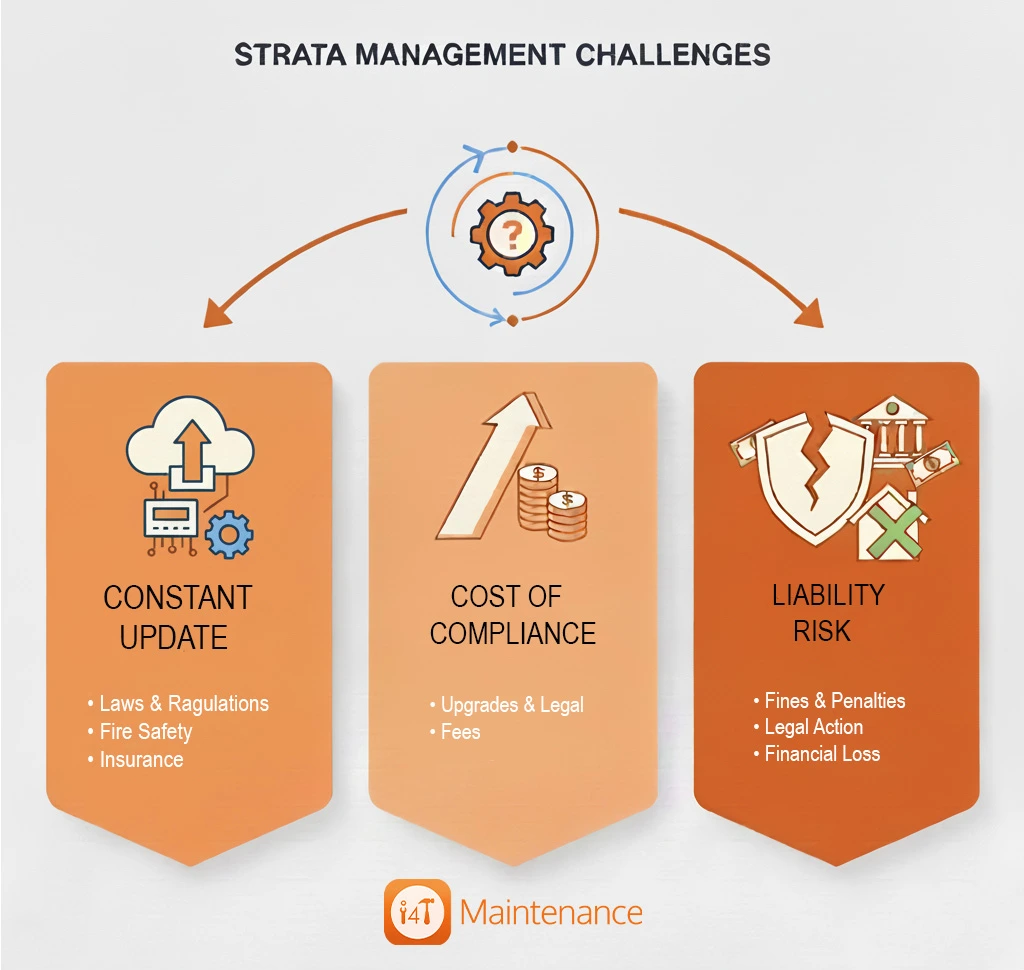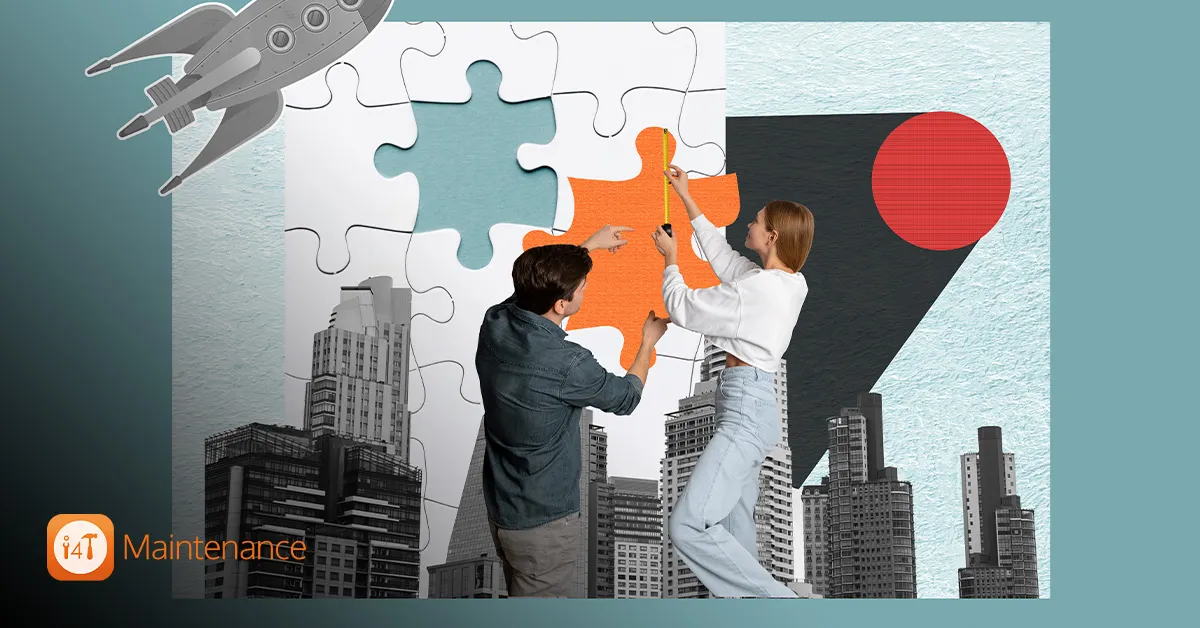Strata management in Australia is changing fast, and 2026 will bring new challenges and opportunities.
From technology making our lives easier to increasing demands for sustainability, strata managers will need to stay on their toes to keep up. At the same time, residents expect more transparency and faster responses, which means communication has never been more important.
In this article, we’ll take a look at the top 5 challenges strata managers will face in 2026.
We’ll dive into how things are changing, what these challenges mean for you, and how you can stay ahead of the curve.
Let’s jump in and explore how you can keep things running smoothly in the years to come!
Evolving Technology in Strata Management
In Australia, over 3.1 million lots are now managed under strata title, with more than 368,000 schemes across the country. With this growth, technology is stepping up to transform how we manage and maintain buildings.
Strata managers are increasingly using technologies like Artificial Intelligence (AI), Internet of Things (IoT) devices, and automation to make things run more smoothly. These tools help with things like predictive maintenance, real-time monitoring of building systems, and improving communication between residents and management.
The Challenge Strata Managers Face
While these new technologies bring lots of benefits, they also come with a few challenges:
- Integration Complexity: Adding new technologies to existing systems can be tricky and expensive.
- Data Management: The amount of data generated by smart devices can be overwhelming and requires solid systems and expertise to manage.
- Training Needs: Staff need to be trained to use these new technologies properly.
To stay on top of these changes, strata managers need to embrace new technologies. This means investing in the right tools, making sure everything works together smoothly, and providing ongoing training for staff. By doing this, you can improve efficiency, cut costs, and make sure residents are happier with the service.
Growing Demand for Sustainable Practices
Sustainability is no longer just a nice idea; it’s becoming a must in strata living!
With more Australians moving into apartment-style living, there’s a growing demand for eco-friendly, sustainable practices in these communities. As a result, strata managers are at the heart of this green movement, working to balance the needs of residents, the environment, and the budget.
More and more people living in strata properties want green solutions, whether it’s energy-efficient systems or waste reduction programs. Additionally, programs like Solar Victoria’s Solar for Apartments initiative are helping communities go green by offering incentives for energy-efficient upgrades.
Finally, sustainable solutions like solar panels and energy-efficient lighting don’t just help the planet; they can also lower utility bills. It’s a win-win for both residents and property owners!
The Challenges Strata Managers Face
While the push for sustainability is strong, it does come with a few challenges:
- Getting Everyone Onboard: Some green initiatives, like installing solar panels, need approval from the owners’ corporation. This can take time and can be tricky to get everyone on the same page.
- Upfront Costs: While sustainable upgrades save money in the long run, they can be expensive to install at first. This can make it harder to convince everyone to invest in them.
- Keeping Up with Regulations: Sustainability rules and regulations are always changing, and strata managers need to stay updated to make sure their buildings are compliant.
Educating residents about how sustainability can save money and improve the building. Help residents understand the long-term benefits of green upgrades.
Consider taking advantage of government incentives and rebates designed to make green upgrades more affordable.
Finally, think long-term and create a sustainability plan that balances environmental goals with your building’s budget. Planning ahead will make it easier to make green changes that stick.
Strata Maintenance Management and Cost Control
When it comes to strata management, maintenance is one of the most important, but often tricky, tasks. As buildings get older and residents’ needs grow, maintenance costs can quickly get out of hand.
In 2026, the pressure to keep maintenance costs under control while keeping buildings safe and functional will only increase.
Why Is Maintenance So Challenging?
Here’s why managing maintenance can be tough for strata managers:
- Rising Costs: As buildings age, repairs become more expensive. Whether it’s plumbing issues or electrical problems, there’s always something that needs fixing. Small repairs can pile up and turn into big, costly problems.
- Preventive vs. Reactive Maintenance: Strata managers face the challenge of balancing proactive maintenance (fixing things before they break) with reactive maintenance (dealing with problems as they happen). Reactive maintenance can be more expensive and disruptive to residents.
- Managing Multiple Contractors: Strata managers often have to juggle several contractors for different maintenance tasks. This can be time-consuming and difficult to manage, especially when you’re handling multiple properties.
To keep maintenance costs under control and make things run more smoothly, here are some steps strata managers can take.
Use predictive maintenance to predict when something might fail before it actually does. Regular inspections and software to track building systems can help spot issues early, preventing bigger, more expensive repairs down the road.
Additionally, you need to streamline maintenance processes to stay on top of tasks, track work orders, and manage contractors. Having everything in one place makes it easier and reduces the chance of errors or missed tasks.
Finally, focus on regular inspections to catch small problems before they turn into big, costly ones. Keeping a regular inspection schedule can cut down on emergency repairs and save you money in the long run.
Legal and Regulatory Changes
Staying on top of the ever-changing legal landscape is a constant challenge for strata managers.
As we move into 2026, things are only going to get more complicated. From new building safety regulations to updates in tenant rights, strata managers need to stay informed and ready to adapt to avoid legal trouble and keep their properties in line with the law.

Why Is It So Challenging?
Understanding and managing legal and regulatory changes is tough because it’s not just about knowing the rules; it’s about knowing how these changes affect your daily tasks.
Here are some of the challenges strata managers face:
- Constant Updates: Laws and regulations are always changing. Whether it’s fire safety codes or insurance requirements, it can be hard to keep track. Staying compliant requires constant attention.
- Cost of Compliance: Keeping up with the latest regulations often requires spending money, whether it’s upgrading building systems to meet new standards or hiring legal help to make sure everything is done right.
- Liability Risks: If you fail to comply with the law, strata managers and property owners can face big financial risks, including fines or even lawsuits.
To best way to stay on top of legal challenges is by keeping informed. Keep an eye on updates from government bodies, legal advisors, and industry groups like Strata Community Australia (SCA).
When things get tricky, it’s always a good idea to talk to a lawyer who knows strata law. They can guide you through complicated situations and help you avoid mistakes.
Finally, use compliance tools to track regulatory changes and alert you when updates happen. These tools can help you manage compliance more easily.
Strata Community Engagement and Communication
Good communication is key to successful strata management. In today’s fast-paced world, strata managers aren’t just looking after buildings; they also need to build strong relationships with a wide variety of owners, tenants, and contractors. With so many different people and expectations, keeping everyone on the same page can be tricky.
Why Is It So Challenging?
There are a few reasons why communication can be tough in strata communities:
- Diverse Communities: Strata communities have people from all walks of life, from young professionals to retirees. Everyone has different preferences when it comes to how they like to receive updates, which can make it harder to keep everyone engaged.
- Different Communication Channels: In the digital world, residents might prefer different ways to get information. Some like emails or mobile apps, while others prefer printed notices or bulletin boards. Strata managers need to make sure everyone gets the info they need, no matter how they prefer to receive it.
- Managing Expectations: With so many people living in one place, managing expectations around things like noise or maintenance can be tricky. Clear communication is essential to avoid misunderstandings and keep things running smoothly.
Some simple strategies can improve communication in your strata community.
Digital tools like strata management software or community apps can help keep residents updated in real time. These tools can manage notices, maintenance requests, meeting updates, and more, making it easier to reach everyone.
Keep everyone in the loop to build trust and reduce confusion.
Finally, give residents a chance to share their thoughts and concerns. Listening to feedback and addressing it promptly helps improve satisfaction and keeps the community feeling positive and connected.
Over to you
As we look towards 2026, it’s clear that strata management in Australia is going to be a bit of a rollercoaster!
From keeping up with new technologies and stricter regulations to managing the growing expectations of residents, the challenges ahead are big, but so are the opportunities to rise to the occasion.
The good news is that every challenge brings a chance to improve and innovate. Whether it’s streamlining maintenance, embracing sustainability, or better communicating with residents, there are plenty of ways to make strata management more efficient, effective, and enjoyable.
i4T Maintenance – Strata Maintenance Management Software is a game-changer when it comes to keeping on top of property upkeep. It helps you manage maintenance tasks, obtain quotes from vetted suppliers, and track work orders, from start to finish, so you can stay ahead of the game and keep your buildings running smoothly.
And anyone looking to improve communication within the community, i4T Community is the perfect solution. It allows owners and tenants to easily report maintenance issues, approve quotes, track progress, and rate service quality.
This creates a transparent, collaborative environment where everyone stays informed and engaged.
By staying proactive, embracing the latest tools, and fostering open communication, you’ll not only meet the challenges of 2026 head-on but also make your strata management experience smoother, more efficient, and more enjoyable for everyone involved.
FAQs
In 2026, technology will make managing strata properties faster and easier. Tools like i4T Maintenance Management Software will help you track maintenance tasks, monitor building systems, and automate daily tasks, so you spend less time on admin and more time keeping things running smoothly.
The best way to save on maintenance costs is by being proactive. i4T Maintenance Management Software helps you stay on top of repairs before they become big, expensive problems. Regular checks and using preventive maintenance tools will help you avoid surprise costs and keep your budget in check.
Good communication makes everything easier. With i4T Community, owners and tenants can easily report issues, approve quotes, track maintenance progress, and rate service quality. It’s a simple way to keep everyone informed, engaged, and happy.
One of the biggest challenges is balancing the cost of eco-friendly upgrades with the need to meet residents’ expectations. But small changes, like installing energy-efficient systems, can save money over time. Plus, there are government incentives available to help make these green upgrades more affordable.
Laws and regulations are always changing, so it’s important to stay informed. You can subscribe to updates from industry bodies and government sources, and work with legal experts to make sure your properties are always compliant with the latest rules.

